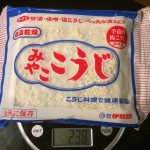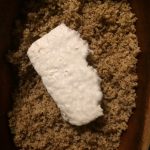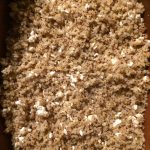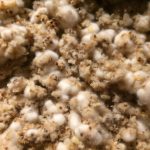In my epic hero’s quest for homebrewing antiquity, I’ve found myself attempting to reconstruct the beverage of China’s ancient bronze age Shang (1700-1046 BC) or Zhou (1046-221 BC) dynasties. Ancient Shang texts name a handful of possible alcoholic beverages — the herbal chang, a potentially sweet and modest rice or millet-based li, and a big rice or millet jiu wine pushing double digits ABV. The later Zhou add the fruited luo and unfiltered rice or millet lao to the tap list.
BRAZEN CAULDRONS
 When it comes to serving your beverage in style, Viking horns don’t hold a candle to the vessels of choice from ancient China. Ornately decorated, cast bronze cauldrons, beakers, and goblets of all shapes and sizes were the name of the game in China’s past. These exquisite objects were employed in grand funerary feasts and ritual festivals honoring the recently departed and distant ancestral spirits.
When it comes to serving your beverage in style, Viking horns don’t hold a candle to the vessels of choice from ancient China. Ornately decorated, cast bronze cauldrons, beakers, and goblets of all shapes and sizes were the name of the game in China’s past. These exquisite objects were employed in grand funerary feasts and ritual festivals honoring the recently departed and distant ancestral spirits.
Like ceramic vessels from ancient Greece, here too we find distinct shapes for different functions — square ding cauldrons for serving and cooking food; lipped beakers for pouring; round tripod cauldrons for holding and warming fermented drink (yes, in BC China they’d prefer a warm one to a cold one); and the tall tapering gu goblet as the last stop before going down the hatch.
BEER GARGOYLES
A dominant decorative device throughout this millennium and a half is the taotie — a monstrous visage grimacing across the face of the vessels. One finds it emblazoning all of the above-mentioned vessel types at various levels of stylization. The taotie is sometimes rather overt and other times a little tricky to suss out from its surrounding decoration. What was its purpose? Why so prevalent? What does it represent? Is it based on an animal form from real life, wholly fantastical, or something in between? Is it an apotropaic gargoyle? Is it meant to scare or protect the living or the dead? While it remains an enigma, the popular theory among scholars is that the form evolves later into more familiar Chinese imagery of ogres and dragons.
EXCAVATING THE ANCIENT ALE
The atmosphere of the feasts in which these vessels were used must have been spectacular. I picture dark, lavish chambers, stinging eyes and dancing shadows from burning braziers, a spectacle of sensory stimulation … sounds of bells and prayers, the sweet odor of burning meat cooked for the spirits and living alike, and the delicate flavors of ancient beer-wine washing down one’s throat. While we don’t have a brewer’s manual from the period, science and archaeology can get us close to answering the eternal question: “But what did it taste like!?” Excavations of vessels in tombs reveal dried-up pits, seeds, and remains of various fruits like peach, plum, and jujube (a Chinese date) and herbs and flowers like chrysanthemum, sweet clover, jasmine, and hemp. Evidence of a species of Artemisia, a relative of wormwood, has also been uncovered, suggesting the beverage could have had a potential psychotropic property. Compounded with the inebriating effect of the alcohol, this could have gone a long way to aid the ancient Chinese ceremonial practices of channeling one’s ancestral spirits. Rarely excavations have actually yielded jars whose lids have effectively “rusted” on tight preserving the 3,000+ year old liquid within. Micro-residue analyses of the dried out dregs encrusting the interiors of ancient vessels yield telltale chemical signatures of rice and millet as the primary fermentables in addition to traces of tree resins, herbs, and flowers. Interestingly, honey and grape, prevalent in the prehistoric Chinese fermented beverage from Jiahu, Henan, made famous by Dogfish Head’s Chateau Jiahu, seem to be absent from Shang and Zhou fermentations.
Despite museum labels and catalogs commonly referring to the alcohol housed within these vessels as wine, all evidence points to the beverage being nothing like our modern notions of grape wine. One could make an argument that it’s a little closer to sake rice wine, but it’s fundamentally a grain-based fermentation, which this blogger prefers to put firmly on the “beer list.”
SPIT OR FUNGUS? MAKE YOU CHOICE
Of additional interest is how those stubborn rice and millet starches were converted to fermentable sugars. Malting is the common process by which that is done with barley, wheat, rye, and other grains. While malting has not been ruled out as a possibility in Chinese bronze age methodology, the evidence seems to point more strongly to two alternatives to malting: the mold saccharification method and mastication, better know as chewing. Chewing of grain was a common practice in different cultures around the world. Beer historians are quick to point to mastication in association with chicha maize beer production in the Andean region of South America. To spare one’s precious molars, the maize (aka corn) would be ground into cornmeal, perhaps almost a flour, and softened with water. Brewers (or more properly brewsters, as we’re dealing predominately with women brewers) would place doughy balls in their mouths, chew and saturate them with saliva, and then spit them out for the fermentation pot. Human saliva, interestingly enough, contains an enzyme (ptyalin) that activates the breakdown of starch into fermentable sugar. Proof that God wanted us to make beer! While there’s no direct evidence supporting mastication in the Chinese bronze age millet and rice beer brewing process, it is attested in among other East Asian cultures (McGovern 2005, 264).
Mold saccharification (or amylolysis fermentation) is a well attested method in China since at least the Han dynasty (c. 206 BC-220 AD). This is also the method employed in Japanese sake and soy sauce production. This involves growing a prominent layer of fungus on the hydrated or cooked grains, which, similar to saliva, breaks down unfermentable starch into simple, fermentable sugars.
Propagating mold on your grain to brew beer!? I don’t know about you, but this bit of Lovecraftian, parasitic, body-snatchers, horror film plot sounded hella-cool to me! So that’s the rabbit hole I went down.
GETTING YOUR MOLD
One can purchase koji rice mold to make sake or soy sauce at home. This is pretty amazing. Imagine a ramen noodle package, but a brick of packed rice instead of noodles and permeating with a heavy white fuzz all throughout. The rice is just the vessel to hold the fuzz. The fuzz is what you’re paying for. If you can’t score this or a similar mold cake at an East Asian market, you can get it on Amazon.
THE MASH

You can easily get millet from a specialty grocery. I toasted a portion of the millet in a pan for fun. It gave off a lovely popcorn aroma. I don’t think it contributed significantly to the flavor or color of the final beverage. You need to simmer the millet in water much as you would the rice. Koji like any other mold wants a plump, hydrated starch to chew on. I cooked about 2 pounds of millet, but that proved to be too much for my clay cooker.
To simplify this experiment, I opted for using my leftover brown rice syrup and sorghum syrup from some past experiment instead of cooking some whole rice, but these syrups are added later in the process. Sorghum is a close relative of millet, so I felt comfortable with this improvisation. This also ensured I’d have some fermentable sugars if the whole koji thing failed.
I transferred the cooked millet to my rustic Römertopf clay cooker. Always ferment in clay for added authenticity! One of these days I hope to commission a massive earthenware fermenter. Maybe I need to talk to my friends at the Oriental Institute. ___[photo me drinking from OI vat]___ When the millet cooled to a warm touch, I added half a koji cake. There are 2 cakes to a package (like ramen), so I only used a quarter package. I had no idea how much would be enough. Slowly I blended the cake with the warm moist millet. As it warmed and moistened, the cake softened, crumbled, and spread evenly through the millet.
I kept the clay cooker in my oven (turned off) for four days, periodically stirring and fluffing the mixture. After a couple days the rice grains from the cake blossomed into little, white, fuzzy balls. In another day after stirring and adding a little more water for moisture, the mold spread throughout the mixture and gave off a bleu cheese odor.
On day 5, I added sufficient filtered water to the cooker to cover the whole mixture and slowly raised the temp of the mash to 120F in my oven, then left it overnight to cool. The following day I strained the liquid from the grains, pressing it through a colander. The liquid was smooth, thick, and opaque. It tasted mildly sweet, as expected, since the koji had converted much of the starch into sugar — and mildly tart, as my abject disregard for the typical sanitization in the brewing process likely permitted some friendly bacteria to take hold, unless that’s also inherent to the koji flavor.
THE BOIL
Enter the aforementioned rice and sorghum syrups plus some more filtered water. I brought the millet-koji wort, water, and syrups to a boil for a few minutes in my brew kettle. Upon turning off the heat, I added a muslin bag with a token amount of jasmine plus an ounce of dried chrysanthemum flowers, then let it gradually cool. I’m a big fan of the no-chill brewing method. There’s no evidence in pre-modern cultures of an attempt to rapidly chill the wort before fermentation.
YEAST
The koji mold effectively serves to malt the grain. It’s not a yeast, so it’s not going to convert the sugars into alcohol. We still need yeast for that. I could opt for a sake yeast, but I don’t want to make sake. Maybe next time I’ll play around with that. Typical sake brewing entails a co-reaction of the koji activating the enzymes to convert starch to sugar and yeast converting sugar to alcohol. I opted for a two-step beer brewer’s approach of malting (koji) and fermenting (yeast).
Picking a yeast for any of my ancient fermentation can feel like a fool’s errand. The yeast can wildly affect the resultant beverage and all modern commercial strains are so heavily cultivated that they likely bear no resemblance to the wild strains of antiquity. Tossing my hands up in frustration, I typically opt for a Belgian blend. I could use a neutral American yeast like US-05 to forefront everything except the yeast, but I feel the neutrality of such a yeast is itself as much an artifact of careful cultivation as the unique properties of today’s commercial specialty strains. Belgian yeast, especially of the abbey variety, is often heralded as a vestigial bit of pre-industrial history, a feral strain somewhat reigned in by brewers, so I like to pretend that it grants a bit of primal authenticity to my ancient ales. And when fermented as a modest temperature, many of the most dominant “Belgiany” esters can be suppressed. With that, my special Morgue Brewing house strain of Belgian yeast is a melange of half a dozen strains that I’ve been harvesting batch after batch and re-pitching for years. Fermented hot, it’s very “Belgiany.” Fermented cool (not lager-cool; just room temp), it’s my ancient yeast.
FERMENTATION
For the most part, this fermentation was fairly straight forward. After adding water and the syrups for the boil, the volume exceeded my clay cooker, so I had to ferment in a carboy. I’d love to do an open air fermentation, but with animals in the house, indoors doesn’t seem like a good idea. My neighborhood being surrounded by the Indiana Dunes National Park, an outdoor fermentation might be something fun to play with one of these days, but I’ll have to watch out for all the local raccoons, deer, and other wildlife.
CHINESE PLUM
Having no Chinese plum, yet the recipe optionally and ostensibly calling for it, I totally shoehorned it and added some prune juice about a week into fermentation. After about 3 weeks of fermentation, I bottled it. Original gravity was 1.040; final gravity 1.008, which yields about 4% ABV. The addition of the prune juice between readings, though, throws off that calculation.
VERDICT
As far as experimentation and different-ness, this ranks right up there with my Mongolian airag fermented milk and my less-than-pleasant Peruvian prickly pear corn chicha. The chrysanthemum comes through strongly with a beautiful floral aroma and flavor. The koji grants it a sake-like smoothness and delectable mushroomy funk. I was rather conservative with the jasmine at flame out and prune juice during fermentation, so I don’t think there was anything perceptible there. This ancient Chinese moldy millet and rice beer has been extremely well received. I scored a 97% at the 2019 SCA Interkingdom Brewer’s Guild competition, being dinged only for lack of documentation, essentially because I only learned about the competition an hour in advance. It was a big hit at the 2019 Michiana Festival of Beers, where I served it as part of the MEGA homebrew club booth. Of greatest accolade, however, was serving it at a party to the indomitable and discerning Tracy Hurst of Metropolitan Brewing and having her actually asking for seconds! … Mic drop.
FUTURE
Next time I’ll do a full mash of millet and rice (no syrups) with the koji working alongside the yeast to simultaneously convert the starch and ferment into alcohol.








